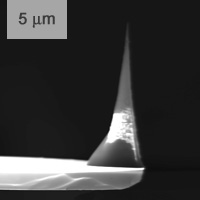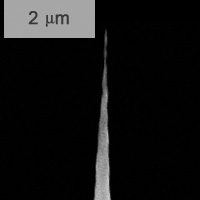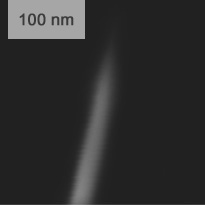產品介紹
-
-
Single Crystal Diamond Tip
SCD probes are single crystal diamond tips specially grown in CVD process and glued to silicon cantilevers for use in AFM. The growth technology provides durable probes with high aspect ratio and small tip radius by affordable price comparable to that of traditional silicon probes. After gluing, each tip passes quality control on SEM before packaging. Beacuse of the high hardness of diamond, the tip can be used for surface modifications and measuring properties of hard materials like silicon, glass, metals, etc. The probe is highly resistant to wear, which is especially useful when fast scanning speed is needed, or when or when there are sharp and rigid edges on surface.
產品說明
Single
|
SCD probes are single crystal diamond tips specially grown in CVD process and glued to silicon cantilevers for use in AFM. The growth technology provides durable probes with high aspect ratio and small tip radius by affordable price comparable to that of traditional silicon probes. After gluing, each tip passes quality control on SEM before packaging. Beacuse of the high hardness of diamond, the tip can be used for surface modifications and measuring properties of hard materials like silicon, glass, metals, etc. The probe is highly resistant to wear, which is especially useful when fast scanning speed is needed, or when or when there are sharp and rigid edges on surface. |
||||||||||||||||
 |
 |
 |
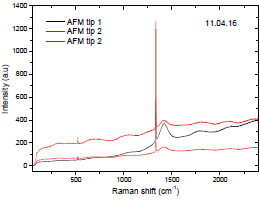 |
||||||||||||||
| SEM image of single crystal diamond (SCD) tip for SPM. | SEM image of the tip aspect ratio over 2 microns from the end. Full cone angle from 5° to 10°. | SEM image of the SCD tip end. Tip radius less than 10 nm. | Raman spectra of SCD tips. Thin diamond line at 1332 cm-1. | ||||||||||||||
|
|
||||||||||||||||
產品應用
|
|||||||||
產品規格
Cantilevers |
|||||||||||||||||||||||||||
|
SCD diamond probes are glued onto rectangular (diving-board) silicon etched cantilevers. The range of spring The chip holder size is 1.6 mm x 3.4 mm x 0.4 mm. |
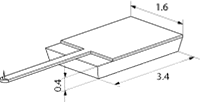 |
||||||||||||||||||||||||||
|
|||||||||||||||||||||||||||
| Note: The glue used to attach the tip to the cantilever is not conducting, so the probe is not applicable for conductive AFM measurements. Values for resonant frequencies and spring constants are typical. |
|||||||||||||||||||||||||||
PackagingProbes are packaged by 5 or 10 per container. |
|||||||||||||||||||||||||||

